Related Research Articles

The Qajar dynasty was an Iranian royal dynasty of Turkic origin, specifically from the Qajar tribe, ruling over Iran from 1789 to 1925. The Qajar family took full control of Iran in 1794, deposing Lotf 'Ali Khan, the last Shah of the Zand dynasty, and re-asserted Iranian sovereignty over large parts of the Caucasus. In 1796, Mohammad Khan Qajar seized Mashhad with ease, putting an end to the Afsharid dynasty, and Mohammad Khan was formally crowned as Shah after his punitive campaign against Iran's Georgian subjects. In the Caucasus, the Qajar dynasty permanently lost many of Iran's integral areas to the Russians over the course of the 19th century, comprising modern-day Georgia, Dagestan, Azerbaijan and Armenia.

Ahmad Shah Qajar was Shah of Iran from 16 July 1909 to 15 December 1925, and the last ruling member of the Qajar dynasty.
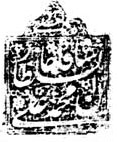
Mohammad Ali Shah Qajar, Shah of Iran from 8 January 1907 to 16 July 1909. He was the sixth shah of the Qajar Dynasty.

Mohammad Shah Qajar was the Shah of Qajar Iran from 23 October 1834 to 5 September 1848.

Mozaffar ad-Din Shah Qajar, was the fifth shah of Qajar Iran, reigning from 1896 until his death in 1907. He is often credited with the creation of the Persian Constitution of 1906, which he approved of as one of his final actions as Shah.

Naser al-Din Shah Qajar was the Shah of Qajar Iran from 5 September 1848 to 1 May 1896 when he was assassinated. He was the son of Mohammad Shah Qajar and Malek Jahān Khānom and the third longest reigning monarch in Iranian history after Shapur II of the Sassanid dynasty and Tahmasp I of the Safavid Dynasty. Nasser al-Din Shah had sovereign power for close to 50 years. He was the first modern Persian monarch who formally visited Europe and also wrote his memoirs.

Mohammad Ali Mirza Dowlatshah was a famous Iranian Prince of the Qajar Dynasty. He is also the progenitor of the Dowlatshahi Family of Persia. He was born at Nava, in Mazandaran, a Caspian province in the north of Iran. He was the first son of Fath-Ali Shah, the second Qajar king of Persia, and Ziba Chehr Khanoum, a Georgian girl of the Tsikarashvili family. He was also the elder brother of Abbas Mirza. Dowlatshah was the governor of Fars at age 9, Qazvin and Gilan at age 11, Khuzestan and Lorestan at age 16, and Kermanshah at age 19.

PrinceAbdol-Hossein Farman Farma was one of the most prominent Qajar princes, and one of the most influential politicians of his time in Persia. He was born in Tehran to Prince Nosrat Dowleh Firouz in 1857, and died in November 1939 at the age of 82. He was the 16th grandson of the Qajar crown prince Abbas Mirza. He fathered 26 sons and 13 daughters by 8 wives. He lived to see four sons of his first wife die within his lifetime.

Prince Abbas Mirza Farman Farmaian Qajar (1890–1935) was an Iranian prince of the Qajar dynasty, the second son of Prince Abdol-Hossein Mirza Farmanfarma of Persia, one of the most preeminent political figures of his time and of the royal Princess Ezzat ed-Dowleh Qajar, the daughter of king Mozaffar-al-Din Shah. He was named after his great-grand father, crown prince Abbas Mirza son of Fath Ali Shah Qajar.
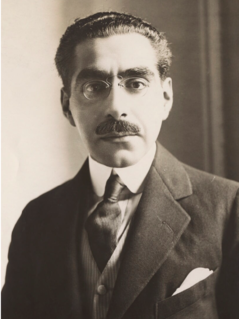
Prince Firouz Nosrat-ed-Dowleh III, GCMG (1889–1937) was the eldest son of Prince Abdol-Hossein Farmanfarma and Princess Ezzat-ed-Dowleh Qajar. He was born in 1889 and died in April 1937. He was the grandson of his namesake, Nosrat Dowleh Firouz Mirza, and of Mozzafar-al-Din Shah Qajar through his mother, Princess Ezzat-Dowleh.
Mohammad Vali Mirza (1891–1983) was the third son of Persian Qajar nobleman Abdol Hossein Mirza Farmanfarma and his wife Princess Ezzat-Dowleh.
Prince Soltan Ali Mirza Kadjar (Qajar) was an Iranian Prince of Qajar Dynasty and the son of Soltan Majid Mirza Qajar (1907–1975) and Homadokht Kian (1912–1992) and the grandson of Mohammad Ali Shah Qajar. He was the Head of the Qajar Imperial Family. Despite Soltan Ali Mirza Qajar being Head of the Qajar Imperial Family, the Qajar claimant to the Sun Throne was the Heir Presumptive Mohammad Hassan Mirza II, son of Soltan Hamid Mirza and grandson of Soltan Ahmad Shah's brother and successor in exile, Mohammad Hassan Mirza Qajar.

Kamran Mirza, was a Persian Prince of Qajar Dynasty and third surviving son of Nasser al-Din Shah. He was the brother of Mass'oud Mirza Zell-e Soltan and Mozzafar al-Din Shah. He was also the progenitor of the Kamrani Family. He might have been Prime minister of Iran for a few days in April–May 1909, but this is not clearly referenced. Kamran Mirza also served as Iran's Commander-in-Chief, appointed in 1868 for the first time, and minister of war from 1880 to 1896 and from 1906 to 1907.

Bahman Mirza was a Persian prince of the Qajar Dynasty, son of Abbas Mirza and grandson of Fath Ali Shah. He was Vicergerent (vali) of Azerbaijan and Governor-General of Tabriz. He later migrated to neighboring Imperial Russia, where he was received with great honour and lived a prestigious life in Shusha. Many of his offspring either returned to Iran where they had political or military careers, or served in the Russian military, and later played an important role in the military of Azerbaijan Democratic Republic. Beside political figures, he is also the great-grandfather of Afrasiyab Badalbeyli, Azerbaijani composer and author of the first Azeri balet and the first ballet in the Muslim East.
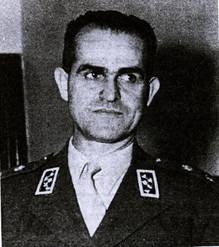
Mahmoud Afshartous, also written Afshartoos, was an Iranian general and chief of police during the government of Prime Minister Mohammad Mossadegh. Afshartous was abducted and killed by anti-Mossadegh conspirators, which helped pave the way for the 1953 coup d'état.

Hajji Mohammad Hossein Isfahani was an architect and political leader in Isfahan, Persia under the rule of Qajar Persian emperor Fath Ali Shah.

Esmat ol-Molouk Dowlatshahi was an Iranian royal and the fourth and last wife of Reza Shah.
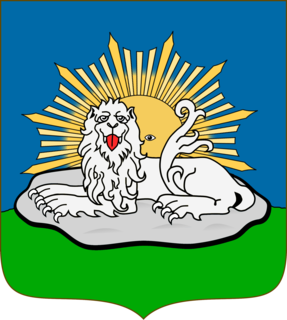
The Bahmani family, also Bahmani-Qajar is an aristocratic Iranian family belonging to one of the princely families of the Qajar dynasty, the ruling house that reigned Iran 1785–1925. The founder is Bahman Mirza Qajar (1810–1884), younger brother of Mohammad Shah Qajar and formerly prince regent and governor of Azerbaijan 1841–1848.

Prince Anoushiravan Mirza "Zia' od-Dowleh" "Amir Touman" was a Persian prince of the Qajar dynasty that ruled Iran 1785-1925. He became a well known politician at the imperial court at Tehran and popular governor of the Iranian province of Semnan in the late 19th century.
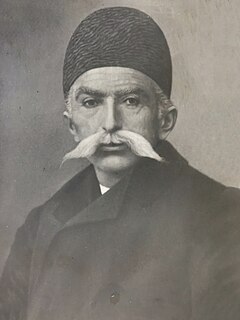
Prince Mehdi Qoli Khan-e Qajar-Qovanlou Amirsoleimani[1] known as "Majd ed-Dowleh", was a prominent Qajar prince and one of the most influential politicians of his time in Persia. He served as steward and administrator during the reign of Nasser al Din Shah.
References
- 1 2 Eskandari-Qajar, Manoutchehr. "Qajar (Kadjar) Titles and Appellations". Qajar (Kadjar) Dynasty Pages. Retrieved 2 July 2015.
- ↑ Curzon, George N. (1892). Persia and the Persian Question. 1. London: Longmans, Green, and Co. p. 451. Retrieved 2 July 2015.